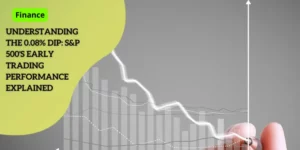Wall Street Plunges as Tech Giants Microsoft and Meta Face High Expectations Fallout

Anúncios
Wall Street took a significant hit as Big Tech stocks plunged, erasing October’s gains and dragging major indices down.
The S&P 500 dropped 1.9%, marking its worst performance in eight weeks.
Anúncios
The Dow Jones Industrial Average fell 378 points, or 0.9%, and the tech-heavy Nasdaq composite tumbled 2.8% for the second consecutive loss.
The sharp decline was a consequence of investor disappointment centered around major tech giants.
Anúncios
Microsoft and Meta Platforms, despite reporting better-than-expected profits, saw their stock prices fall due to concerns over future growth and spending.
S&P 500’s Steep Decline
The S&P 500’s 1.9% fall was a clear indication of the market’s sensitivity to high expectations from tech companies.
This was the index’s sharpest drop in two months, reflecting broad investor unease.
The index’s performance was heavily influenced by the slump in Big Tech stocks, including Microsoft and Meta, both of which have a considerable presence in the S&P 500.
Dow Jones Industrial Average’s Drop
The Dow Jones Industrial Average was not spared, dropping 378 points (0.9%).
The fall was driven by the same forces affecting the S&P 500, with investors reacting negatively to tech earnings reports and broader market uncertainty.
The tech-related declines had a ripple effect across other sectors, showing how interconnected market performance is.
Nasdaq Composite’s Continued Tumble
The tech-centric Nasdaq composite faced the brunt of the downturn.
It tumbled 2.8% for the second straight day, largely due to significant losses in major tech stocks.
Companies like Microsoft, Meta, Amazon, and Apple saw their shares stumble, contributing to the composite’s decline.
This continued fall underscores the high volatility within the tech sector and the broader market’s dependence on tech performance.
This severe market reaction highlights the critical role that investor expectations play in stock performance.
Even when companies deliver solid financial results, any deviation from high growth forecasts or warnings of increased future expenditures can lead to substantial market losses.
As we transition into examining individual company performances and their impact on the broader market, it becomes clear how critical Big Tech’s influence is.
The next section will delve deeper into Microsoft’s reported financials and the market’s response.
Microsoft’s Performance and Market Response
Stellar Earnings But Disappointing Forecasts
Microsoft’s latest earnings report painted a picture of success at first glance.
The tech giant surpassed analysts’ expectations with robust profit growth and revenue, driven particularly by its various enterprise services and products.
Despite these seemingly positive outcomes, a shadow of doubt quickly emerged among investors concerning the growth forecasts for Microsoft’s Azure cloud-computing business.
Focus on Azure’s Future
Azure, Microsoft’s cloud computing service, has been a bedrock of its growth strategy.
However, the company’s projections for Azure signaled slower growth than anticipated, which spooked investors.
The high hopes pinned on Azure’s expansion created a significant pressure point.
As analysts delved into the details, it became clear that Azure’s growth trajectory might not match the meteoric rise it enjoyed previously.
Market Reacts
Investor reaction was swift and severe. Despite the strong overall performance, Microsoft’s stock tumbled 6%.
This sharp decline underscored how sensitive the market has become to even the slightest hint of deceleration in key growth areas.
Rather than celebrating the current profits, shareholders fixated on the subdued outlook for Azure, casting a pall over the earnings report.
Broader Implications
Microsoft’s plummet had a ripple effect that extended beyond its own shares.
It was a significant contributor to the overall market downturn, contributing to the S&P 500’s worst day in eight weeks, the Dow Jones’ drop, and the Nasdaq’s prolonged slump.
This episode highlighted the outsized influence that Big Tech companies like Microsoft wield over broader market sentiment.
Transition
As the market digested Microsoft’s mixed signals, attention turned to another tech titan grappling with its own set of challenges—Meta Platforms.
While Meta’s earnings initially appeared strong, the company’s forward-looking statements stirred up fresh investor anxieties.
Meta Platforms’ Earnings Impact
Meta Platforms, parent company of Facebook, joined the ranks of major tech giants that disappointed investors despite delivering a promising profit report.
The company managed to exceed profit expectations for its latest quarter, but this success was quickly overshadowed by their forward-looking statements.
Meta’s stock took a 4.1% hit following their warning about a significant uptick in expenditure projected for 2024.
Investor Concerns Over Accelerated Spending
A major point of contention for investors was Meta’s announcement of accelerated spending.
The company is planning to inject a substantial amount of its resources into AI development, a move that’s aimed at staying competitive in the rapidly evolving tech landscape.
However, while Meta views this as a necessary step to secure future growth, investors are wary of the short-term financial burden this entails.
The anticipated increase in costs sparked fears about potential impacts on profit margins, leading to a swift and negative market reaction.
The AI Investment Dilemma
Artificial intelligence is undeniably a cornerstone for future tech innovation, and Meta is betting heavily on it.
The company’s commitment to AI development aligns with the broader industry trend and the increasing importance of AI-driven technologies.
Despite the strategic importance, the heavy investment in AI is a double-edged sword. While promising long-term growth, it also comes with high immediate costs.
This delicate balance between future potential and current financial strain has proven difficult for investors to digest, contributing to the pullback in Meta’s stock price.
High Expectations and Market Realities
Just like Microsoft, Meta has been part of the AI hype that has lifted tech stocks to impressive heights.
The rapid ascent in stock prices set sky-high expectations, posing a considerable challenge in consistently meeting or exceeding them.
The slightest hint of increased spending or slower growth can trigger significant market reactions, as evidenced by Meta’s recent stock dip.
This sensitivity highlights the fine line major tech companies must navigate between pursuing innovation and managing investor expectations.
Such incidents underscore the broader concerns about tech sector valuations and the pressures of sustaining high growth rates.
As Meta and other major tech players continue to navigate these treacherous waters, the broader market remains highly responsive to every piece of news or projection, reinforcing a volatile environment.
As we delve into the broader market implications next, it becomes clear how the tech sector’s movements reverberate through the entire financial landscape.
Tech Sector Valuation Concerns
Rapid Price Climb and Its Critics
The tech sector has been on an impressive run, with stock prices of big players like Microsoft and Meta Platforms soaring.
This meteoric rise, however, has brought along its set of concerns.
Critics argue that these stock prices have climbed too rapidly, putting them at high valuation levels that are difficult to justify in the context of future growth prospects.
High expectations from investors add to the tension. Companies are now under pressure to continually outperform their previous achievements, which isn’t always sustainable.
The recent declines in Microsoft’s and Meta’s stock prices, despite healthy profit reports, highlight this challenge.
Investors are unwavered by current successes and are instead closely scrutinizing future growth forecasts and spending plans.
Meeting Market Demands
The lofty expectations have created a daunting task for tech giants.
To meet market demands, these companies must not only maintain but also significantly improve their performance.
The backlash against Microsoft’s Azure forecasts and Meta’s AI investments underscores the market’s brittle sentiment.
Investors are quick to penalize any perceived shortfall, reflecting a precarious balance between growth and valuation.
For instance, Meta’s announcement of accelerated spending in AI development triggered a 4.1% drop in its shares.
While AI has the potential for long-term profit, the immediate substantial costs are unsettling investors.
Similarly, Microsoft’s 6% stock decline was tied to growth forecasts for its Azure service, despite otherwise strong quarterly results.
Big Tech’s Broader Market Influence
Big Tech’s sway over the broader market cannot be overstated.
This sector’s performance significantly affects major indices like the S&P 500, Dow Jones Industrial Average, and Nasdaq composite.
The dip in tech stocks not only led to their downfall but also dragged these indices down, erasing October’s market gains.
The ripple effect was observed across other sectors too. As tech stocks declined, the overall market sentiment soured, influencing even well-performing areas like oil and gas.
The pressure on tech stocks is indicative of their heavy weight within the market indices, making their performances critical for overall market health.
As we navigate through these valuation concerns, it’s essential to consider how these dynamics interplay with broader market trends and economic indicators.
Balancing high expectations with achievable growth remains a critical challenge for the tech sector moving forward.
Broader Market Implications
The recent turmoil in the tech sector has spilled over, erasing October’s gains and shaking investor confidence.
This tech-driven downturn has had significant ripple effects across major indices, wiping out the S&P 500’s monthly gains and putting an end to its six-month winning streak.
The S&P 500 fell by 1.9%, Dow Jones stumbled 0.9%, and the Nasdaq experienced a sharp decline at 2.8%, making for a tough second consecutive loss.
Oil and Gas Sector Resilience
Contrary to the tech sector’s woes, the oil and gas industry has shown remarkable resilience.
Companies in this sector received a boost from rising crude oil prices, which gained 0.9% to reclaim some recent losses.
This positive movement resulted in gains for major players like ConocoPhillips, which jumped 6.4%.
Here, the oil and gas sector emerged as a bright spot, helping to partially offset the broader market’s negative sentiment.
Mixed Economic Indicators
The broader market is currently navigating a sea of mixed economic indicators.
On one hand, recent reports on the U.S. economy present a nuanced picture.
A report preferred by the Federal Reserve showed inflation cooling down to 2.1% in September from 2.3%.
This figure is nearly on target with the Fed’s 2% goal, igniting some cautious optimism.
However, core trends, which exclude volatile food and energy prices, were slightly hotter than anticipated.
Additionally, wage and benefits growth decelerated over the summer, potentially easing future inflation pressures.
Meanwhile, jobless claims fell, indicating that layoffs remain low across the country.
These mixed signals have created a complex backdrop for market participants, with fluctuations in treasury yields reflecting the prevailing uncertainty.
Transition to Next Topic
This intricate dance of economic signals, combined with sector-specific performances, paints a vivid picture of a market in flux.
What stands out is the significant influence of tech stocks on the broader market sentiment.
The interplay between various sectors and economic indicators sets the stage for further exploration of market dynamics and investor strategies.
With this detailed look at the broader market implications, we’ll further delve into how specific sectors and economic forecasts shape market trends.






